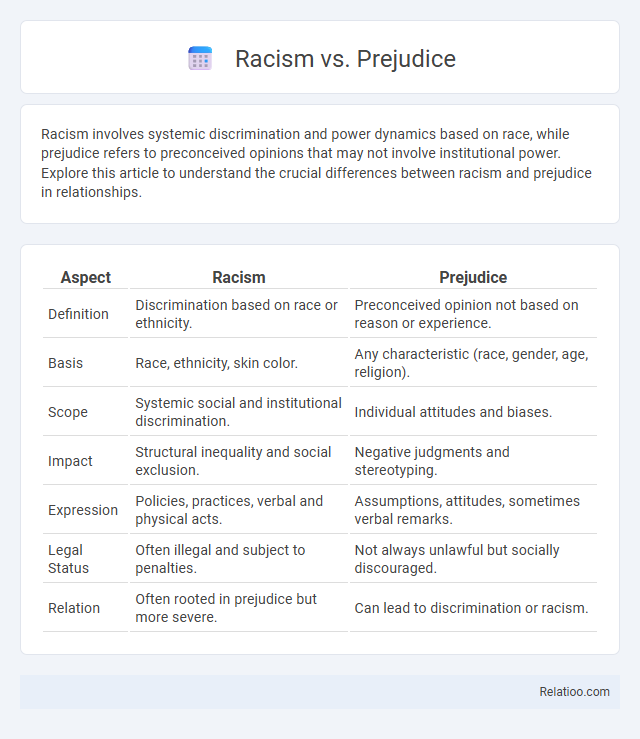Racism involves systemic discrimination and power dynamics based on race, while prejudice refers to preconceived opinions that may not involve institutional power. Explore this article to understand the crucial differences between racism and prejudice in relationships.
Table of Comparison
| Aspect | Racism | Prejudice |
|---|---|---|
| Definition | Discrimination based on race or ethnicity. | Preconceived opinion not based on reason or experience. |
| Basis | Race, ethnicity, skin color. | Any characteristic (race, gender, age, religion). |
| Scope | Systemic social and institutional discrimination. | Individual attitudes and biases. |
| Impact | Structural inequality and social exclusion. | Negative judgments and stereotyping. |
| Expression | Policies, practices, verbal and physical acts. | Assumptions, attitudes, sometimes verbal remarks. |
| Legal Status | Often illegal and subject to penalties. | Not always unlawful but socially discouraged. |
| Relation | Often rooted in prejudice but more severe. | Can lead to discrimination or racism. |
Understanding Racism: Definition and Origins
Racism involves systemic discrimination and power imbalance based on race, whereas prejudice refers to preconceived opinions without factual basis, often rooted in stereotypes. Understanding racism requires examining historical contexts, such as colonialism and slavery, which established structural inequalities that persist today. These origins reveal how institutional policies and social norms perpetuate racial biases beyond individual attitudes.
What Is Prejudice? Unpacking the Concept
Prejudice refers to preconceived opinions or attitudes about individuals or groups based on characteristics such as race, ethnicity, religion, or gender, often without factual evidence or personal experience. Unlike racism, which involves systemic power dynamics and institutional discrimination, prejudice is primarily about biased beliefs and feelings held by an individual. Understanding prejudice requires analyzing its cognitive and affective components, including stereotyping and emotional responses, which contribute to unfair treatment and social division.
Key Differences Between Racism and Prejudice
Racism involves systemic power structures that enforce discrimination based on race, whereas prejudice refers to preconceived opinions or attitudes without necessarily involving power dynamics. Your understanding of these distinctions is crucial because prejudice can exist without racism, but racism requires both prejudice and social power to impact marginalized groups significantly. Recognizing these key differences helps in identifying root causes and effectively addressing social inequalities.
Historical Contexts: Racism and Prejudice Through Time
Racism has historically manifested as systemic oppression rooted in power dynamics, exemplified by colonialism and slavery, where entire racial groups were dehumanized and exploited. Prejudice encompasses preconceived negative judgments based on race, ethnicity, or other characteristics, often serving as the social foundation for discriminatory policies throughout history. While both concepts have evolved, understanding their distinct roles in institutions like Jim Crow laws and apartheid highlights how prejudiced attitudes escalate into entrenched racist structures.
The Psychological Roots of Prejudiced Thinking
Prejudiced thinking often originates from deep-seated cognitive biases and social conditioning that shape how Your brain categorizes and evaluates others based on race, ethnicity, or group identity. Racism stems from systemic structures that enforce inequality, whereas prejudice involves preconceived negative attitudes without necessarily involving power dynamics. Understanding these psychological roots, including the role of in-group favoritism and fear of the unknown, is crucial to dismantling biases and promoting genuine social equity.
Systemic Racism vs Individual Prejudice
Systemic racism refers to the embedded policies and institutional practices that create and sustain racial inequalities across social, economic, and political systems, affecting entire communities. Individual prejudice involves personal biases, attitudes, and discriminatory behaviors held by individuals against others based on race or ethnicity. Understanding the distinction highlights that systemic racism operates beyond individual intent, perpetuating inequality through structural mechanisms, while individual prejudice reflects personal expressions of bias.
Cultural Influences on Racism and Prejudice
Cultural influences shape racism and prejudice by embedding societal norms, beliefs, and values that either challenge or perpetuate biased attitudes and discriminatory behaviors. Media representation, education systems, and family traditions contribute to the formation of stereotypes and cultural narratives that sustain racial prejudices and systemic inequalities. Understanding these cultural factors is crucial for developing effective interventions to reduce racism and promote social inclusivity.
Effects on Society: Racism vs Prejudice
Racism causes systemic inequalities by embedding discriminatory practices in institutions, leading to unequal opportunities in education, employment, and justice for marginalized groups. Prejudice often manifests as negative attitudes or stereotypes that can fuel social tensions and reinforce divisions but may not always result in structural discrimination. Understanding the distinct societal effects of racism versus prejudice helps you recognize the deeper, institutional harm racism inflicts compared to the interpersonal nature of prejudice.
Addressing and Combating Racism and Prejudice
Addressing and combating racism and prejudice requires actively challenging biased beliefs and systemic inequalities through education, policy changes, and inclusive practices that promote equity and respect. Understanding that racism involves institutional power dynamics while prejudice centers on preconceived negative attitudes helps tailor effective interventions in communities and workplaces. Your commitment to recognizing and disrupting both overt and subtle forms of discrimination plays a crucial role in fostering a more just and inclusive society.
Building Awareness: Moving Towards Equality
Building awareness around racism, prejudice, and discrimination is crucial for fostering equality and social justice. Racism involves systemic power imbalances and institutional policies that marginalize groups based on race, while prejudice refers to preconceived negative attitudes toward individuals or groups without evidence. Promoting education, empathy, and inclusive dialogue helps dismantle stereotypes, challenge implicit biases, and create environments where diversity is valued and equitable opportunities are accessible for all.

Infographic: Racism vs Prejudice
 relatioo.com
relatioo.com